Cover image: Dominaria United Preview Art by Lorenzo Lanfranconi
Today we have a treat for you: a free preview from Wizards from the upcoming set Dominaria United! Thank you to Wizards for providing this free preview.
For three decades, amongst those in the know, a 2/2 for two generic and one colored mana has been called a “Gray Ogre,” after Alpha’s red creature. It wasn’t the only creature of that class, as Alpha also gave us Black’s Scathe Zombies and White’s Pearled Unicorn—as well as Gray Ogres with significant upsides in Granite Gargoyle and Sedge Troll.
Why, then, did we call 2/2’s for three a “Gray Ogre” instead of a “Pearled Unicorn?” It’s briefer, certainly, but I would argue it’s a more Magical name and one that didn’t offend the sensibilities of Magic’s early player base. “Pearled Unicorn” doesn’t sound martial. It sounds like the sort of pewter-and-crystal tchotchkes sold in 1990’s hobby shops, right next to the boxes of Ice Age and Hyborian Gates and Doom Trooper.
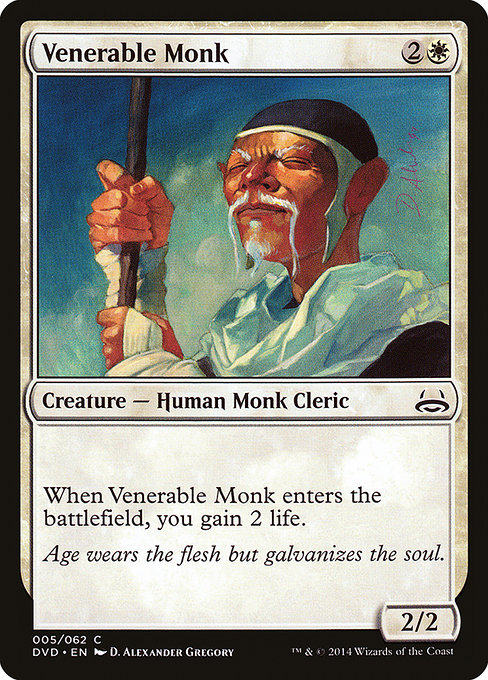
I’m bucking that ancient trend and calling it “Pearled Unicorn” instead, for reasons that will become imminently clear. Whatever you call it, though, it was one of the benchmarks of Limited and, believe it or not, later iterations like Man-o’-War and Trained Armodon were considered somewhat outrageous for how they greatly obsoleted the humble Pearled Unicorn. Venerable Monk and Benalish Lancer don’t quite cut it when your opponent is packing Gnarled Mass. Invasion’s Battlemages were the last gasp of the old Pearled Unicorn—good on turn three, extremely relevant when kicked during a point in the game when Pearled Unicorn was absurdly obsolete.
That obsoletion was complete by Onslaught. The format was a battle royale of Gray Ogres, as every color suddenly had a universal turn three 2/2. In Limited, it was often correct to play entirely off-color Morphs to ensure you could at least trade with your opponent’s early Morphs, and Zombie Cutthroat was a bonafide first pick card, as it came down as a Morph and ate opposing Morphs even when you were tapped out.
Pearled Unicorn is thoroughly outclassed now, of course, in a world of Attended Knight, Abzan Falconer, and Kor Hookmaster—to say nothing of Monastery Mentor, Brutal Cathar, or Extraction Specialist. A 2/2 for two generic and one White just doesn’t pass muster anymore, but cards based on that model have defined Limited formats, from Champions powerhouse Kitsune Blademaster to Trusted Pegasus to various riffs on Auramancer.
It’s a point on the curve that’s critical in Limited, and so Wizards has returned to the Unicorn many times. Before today, there were 125 Pearled Unicorns in Magic history, from Femeref Knight to Roving Knight. Wizards of the Coast has graciously provided a free preview for us today, so let’s make it 126. No slow reveals here—let’s mount up with Sir Orc:
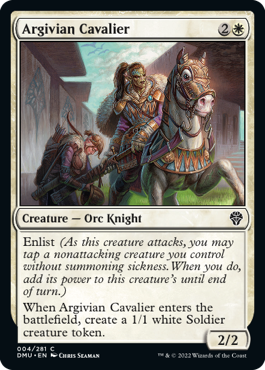
Chris Seaman has done an incredible job of presenting Argivian Cavalier: they’re not in the graceful, airy architecture of New Benalia, but in a more utilitarian, open-air complex of barracks. Even then, they’re branded with a symbol strongly reminiscent of the Coalition. Unlike New Benalia’s ostentatious stained glass armaments, this Orc Knight is clad in fur and armor—but still in vibrant colors that hint at nobility and a connection to the gaudy Benalish army.
The second thing I noticed was that type line: Orc Knight. It’s not the first Orc Knight we’ve seen, with recent Alchemy-exclusive Boareskyr Tollkeeper and last year’s Devoted Paladin, but it is Dominaria’s first Orc Knight. Traditionally, Dominarian Orcs are Tolkeinesque Orcs—bellicose, primitive, and threatening. To start dubbing in Orcs, New Argive must be desperate, but the fact that they’ve been conscripted as a Cavalier, and not an infantryman, implies both Orcish and Argivian societies are adapting to the Phyrexian threat and growing less insular and anthrochauvinist. Argivian Cavalier comes with their own squire: a 1/1 Soldier token.
Cavalier gives you three power and three toughness, split up over two bodies—not as good as a 3/3 for three, but then it wouldn’t be a Pearled Unicorn. The closest analogue to Argivian Cavalier is Attended Knight, which was rock-solid back in Magic 2013. Producing a 1/1 isn’t a huge game, but when it can serve as a chump blocker or as a pseudo +1/+1 counter, as Enlist enables, then the flexibility is worth more than just a simple token.
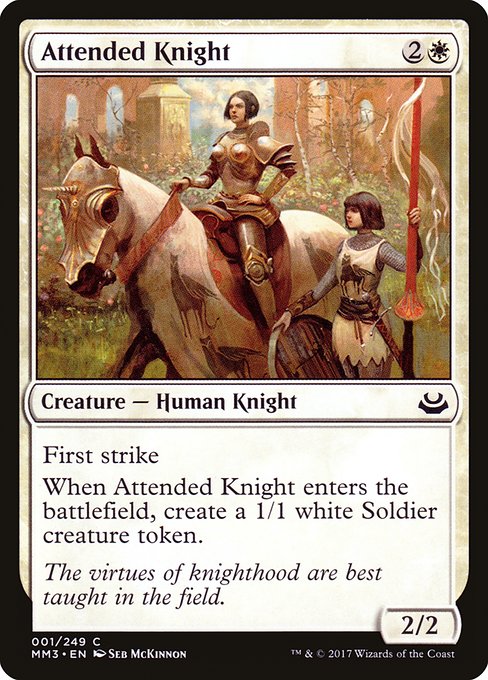
Unlike Attended Knight and Ballyknock Cohort, which were both exceptional in their formats of choice, Argivian Cavalier is missing First Strike. So it’s not quite Attended Knight, and it’s not quite Benalish Cohort, and it’s not quite Sandcrafter Mage—but, with Sheoldred seeding New Argive with Phyrexian sleeper agents, every Knight counts.
This, so far, has been assuming an empty board, with the Orc Knight Enlisting their humble Soldier confrere. But Enlist is more than that: it’s a kind of super-charged Exalted: your 3/1’s that can’t charge recklessly into combat anymore now can link up with your Cavalier, and your 2/2 flyers that can’t attack into your opponent’s larger board suddenly can buff your Enlist creatures.
So long as you have another creature without summoning sickness, you can link them up with your Enlister, making combat math trickier for your opponent and Haste even more valuable in Limited. Sometimes, you’ll run into a situation where your 2/2 and your 3/3 can’t profitably attack, but a theoretical 5/5 would—Enlist allows you to stitch those two creatures together into a more powerful attacker.
More than anything, Enlist is reminiscent of one of Magic’s original mechanics: Banding. As soon as Wizards previewed the mechanic last week, people started making that connection, as it is a pretty blatant and cheeky callback to one of early Magic’s least-loved mechanics. Old Magic players love talking about Banding—while the mechanic didn’t last long, it’s a bonding experience to puzzle through the ramifications of Banding.
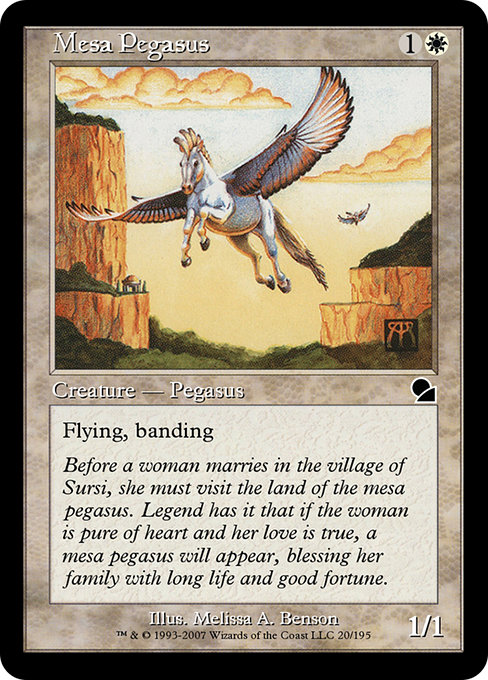
Banding, for those not in the know, was a very early Magic mechanic (1993-1997) that allowed any number of creatures with Banding, and up to one without Banding, to be declared attacking as a “Band.” When that Band was blocked, the attacking player, and not the defending player, chose how damage from blocking creatures was assigned to the Band. This generally resulted in: a) the attacking player losing the smallest creature in the band, as it absorbed all of the damage, or b) the damage being sent to the largest creature in the band, which lived.
That’s the theoretical benefit of banding—from my experience, it mostly resulted in schoolyard arguments about whether it was fair to assign more damage than it took to kill the smallest Banding creature (A: yes) or whether you could block a band if one of the creatures had Swampwalk and you had Swamps (A: yes).
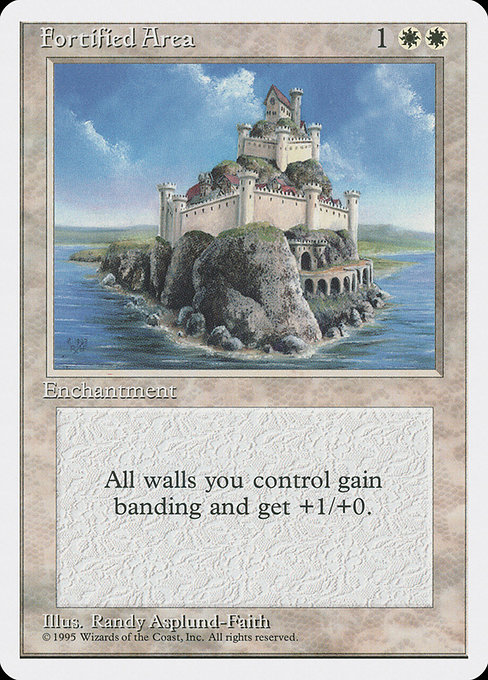
Conversely, if a Band blocks (this time only a single creature with Banding can band with any number of other creatures to block as a band), the defending player chooses how damage from an attacker is assigned. The outcome was generally the same as when attacking, which is to say: somebody got called a cheater and everyone consulted the tinily-fonted rulebooks to unsuccessfully decipher what Banding meant. On top of that, the more flexible rules for blocking with a single Banding creature joining up with many others meant that an unaware attacking player could be caught completely by surprise, losing their powerful attacker where they never expected such an outcome.
It has since been streamlined down to card length. The Gatherer text, per Banding Sliver, for Banding is: “Any creatures with banding, and up to one without, can attack in a band. Bands are blocked as a group. If any creatures with banding you control are blocking or being blocked by a creature, you divide that creature’s combat damage, not its controller, among any of the creatures it’s being blocked by or is blocking.”
We will not go into “Bands with Others,” because we are mortal and our time is thus valuable. Don’t ask.
Banding, quite simply, has not been revisited because it a) is only infrequently relevant; b) when it is relevant, complicates combat; and (c) operates differently for attacking and blocking. I’m honestly surprised that we haven’t seen a Legendary creature that spells it out a la Banding Sliver, but we still have a whole host of Dominaria United cards left to see.
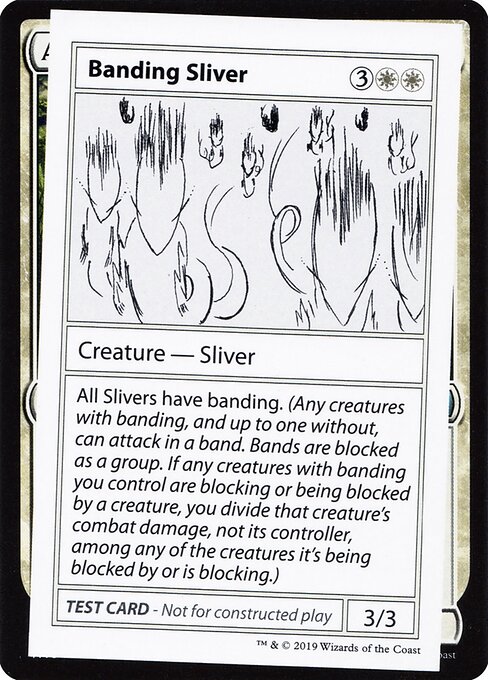
In the meantime, we have Enlist, which demonstrates why Dominaria is such an appealing plane: as the central focal point of Magic narrative, it’s a chance for Wizards to consider Magic as a game system and revisit the buggier elements for further revision. It’s an incredibly resonant thing—we all wish we could correct our past mistakes or show off our earned laurels organically (notably, this is why Neon Dynasty was a showy home run).
Even something as simple as a Limited common is placed in full context of the last thirty years of Magic development, and spirals out into a full narrative about what Magic was and what it means. Dominaria allows Wizards to interpret Magic; it offers us all the chance to self-reflect on how far we’ve come and how much history we share.
A lifelong resident of the Carolinas and a graduate of the University of North Carolina, Rob has played Magic since he picked a Darkling Stalker up off the soccer field at summer camp. He works for nonprofits as an educational strategies developer and, in his off-hours, enjoys writing fiction, playing games, and exploring new beers.

